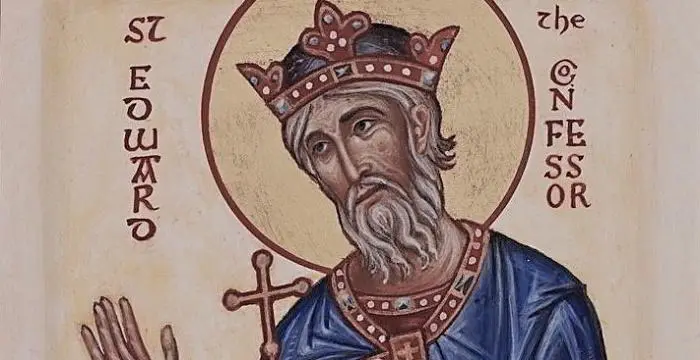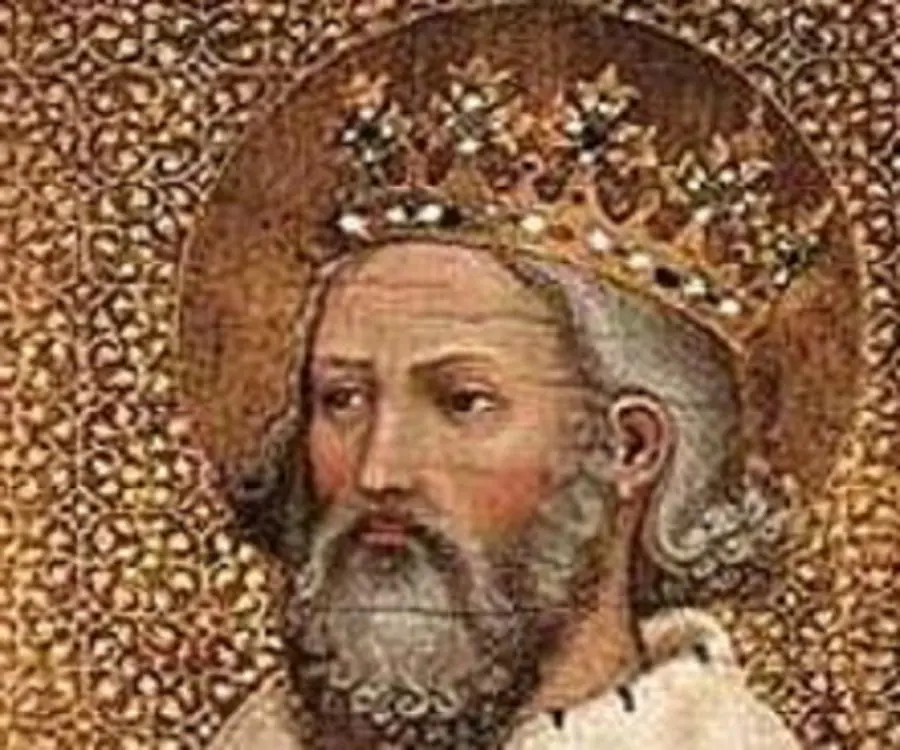
Edward the Confessor - Emperors, Family and Childhood
Edward the Confessor's Personal Details
Edward the Confessor was an Anglo-Saxon king who ruled from 1042 to 1066
| Information | Detail |
|---|---|
| Birthday | 1003 |
| Died on | January 5, 1066 |
| Nationality | British |
| Famous | Historical Personalities, Emperors & Kings, Emperors, Kings |
| Spouses | Edith of Wessex (m. 1045) |
| Siblings | Alfred, Godgifu |
| Known as | Saint Edward the Confessor |
| Birth Place | Islip |
| Gender | Male |
| Father | Æthelred the Unready |
| Mother | Emma of Normandy |
| Born in | Islip |
| Famous as | King |
| Died at Age | 63 |
// Famous Kings
Sundiata Keita
Sundiata Keita was the founder of the Mali Empire in West Africa. This biography profiles his childhood, early life, struggles, founding of empire, rule, administration, achievements and also gives some fun facts.
Ashoka
Ashoka was the third emperor of the Mauryan Dynasty and ruled almost the entire Indian subcontinent. This biography profiles his childhood, life, reign, achievements and timeline
Murad IV
Murad IV was one of the mighty Sultans in the history of the Ottoman Empire. This biography profiles his childhood, family, accession, rule, administration and timeline.
Edward the Confessor's photo
Who is Edward the Confessor?
Edward the Confessor, also known as Saint Edward the Confessor, was one of the last Anglo-Saxon kings of England. He ruled from 1042 to 1066. Though many regarded him as an ineffectual monarch who was overshadowed by the nobles, he is known for preserving the unity of the kingdom and dignity of the crown throughout his reign. He was born as the seventh son of Æthelred the Unready, and the first by his second wife. He ascended to the throne after the death of the reigning King of England, his half-brother Harthacnut. In his claim to the throne, he was supported by the powerful English earl Godwin. His nickname portrays a traditional image of him as pious and unworldly. His name also reflects his image as a saint who did not suffer martyrdom, unlike King Edward the Martyr. His reputation for piety grew in the years after his death. He had a childless marriage and his childlessness was attributed to his commitment to a celibate lifestyle. He was also known for issuing prophecies and for performing miracles. During the Middle Ages, he became one of the favorite saints of English kings such as Henry III and Richard II.
// Famous Emperors
Sundiata Keita
Sundiata Keita was the founder of the Mali Empire in West Africa. This biography profiles his childhood, early life, struggles, founding of empire, rule, administration, achievements and also gives some fun facts.
Ashoka
Ashoka was the third emperor of the Mauryan Dynasty and ruled almost the entire Indian subcontinent. This biography profiles his childhood, life, reign, achievements and timeline
Murad IV
Murad IV was one of the mighty Sultans in the history of the Ottoman Empire. This biography profiles his childhood, family, accession, rule, administration and timeline.
Childhood & Early Life
Edward was born sometime between 1003 and 1005. He was the seventh son of Æthelred the Unready and his second wife Emma of Normandy. He had two full siblings, a brother Alfred and a sister Godgifu. He was always listed behind his half-brothers in charters, which showed that he ranked behind them.
During his childhood years, England was targeted by the Vikings under Sweyn Forkbeard and his son Cnut. Sweyn eventually seized the throne in 1013. Following this, Edward and his mother fled to Normandy. Soon after, his father joined them.
Sweyn passed away a year later, in 1014, and Æthelred came back to power. Æthelred himself passed away in 1016, after which Edward’s half-brother Edmund became the new king.
Edmund carried on the fight against Sweyn’s son, Cnut, and it is also believed that Edward fought alongside Edmund. However, Edmund also passed away the same year, in November 1016. Edward then went into exile along with his siblings. His mother married Cnut in 1017.
Eadwig, Edward’s last surviving elder half-brother was executed by Cnut. This made Edward the leading Anglo-Saxon claimant to the throne. Edward spent nearly a quarter of a century in exile. His whereabouts during this time is assumed to be Normandy, although there is little evidence to support it. He is said to have received support from his sister Godgifu, who had married Drogo of Mantes, the count of Vexin.
With Emma, Cnut had a son named Harthacnut, who succeeded him as the King of Denmark after Cnut passed away in 1035. Harthacnut was too busy defending his position in Denmark, so it was unclear whether he also intended to keep England.
Later, it was decided that Harold Harefoot, Harthacnut’s elder half-brother, would act as regent, and Emma would hold Wessex on behalf of Harthacnut. When Harold wanted to take over as king, Emma asked for Edward’s help to counter Harold’s attempts.
Though Edward is said to have fought a skirmish near Southampton, he eventually had to retreat to Normandy. Harold was eventually accepted as the king in 1037, and the following year, he expelled Emma. She asked Edward to help Harthacnut, but Edward had no resources for invasion. He also showed no interest in the throne. Harold eventually died in 1040, after which Harthacnut successfully took over the English throne.
Ascension & Reign
Harthacnut passed away in June 1042 and Edward was supported by Godwin, the most powerful of the English earls, in his claim to the throne. Edward was crowned the new king in London, at the cathedral of Winchester, the royal seat of the West Saxons, on 3rd April 1043. Shortly after his ascension, he seized the property of his mother, who is believed to have plotted against his ascension.
The first eleven years of his reign are believed to have been ineffectual, as England was mostly controlled by the Earl of Wessex, Godwin. Edward had the right to appoint bishops. He married Edith, Godwin’s daughter, in 1045.
A major disagreement occurred between Godwin and Edward after a few years. Archbishop Robert accused Godwin of plotting to assassinate Edward. Enraged, Edward eventually outlawed the Godwin family and also sent Edith away to a nunnery. The Archbishop also urged Edward to divorce her.
Edward’s favoritism to the Normans caused further problems with his nobles, and in 1052, Godwin and his sons were able to return again. Since they were not prepared for a civil war, Edward was forced to make peace with them.
As a result, Godwin’s lands had to be returned to him and Edward’s Norman forces were exiled. Godwin passed away in 1053, after which his son Harold took on his title, and became known as Harold of Wessex. He became the most powerful nobleman in England.
As a result, Godwin’s lands had to be returned to him and Edward’s Norman forces were exiled. Godwin passed away in 1053, after which his son Harold took on his title, and became known as Harold of Wessex. He became the most powerful nobleman in England.
Marriage
Edward married Godwin's daughter Edith on 23 January 1045. The marriage was childless. It is believed that Edward was dedicated to a celibate lifestyle and that is why Edith didn’t bear any child.
Death & Aftermath
Edward the Confessor passed away on 5th January 1066. He was buried at Westminster Abbey the next day, after which Harold was immediately crowned the next king. Edward had named Harold his successor shortly before his death, though he had previously promised the crown to William, duke of Normandy.
According to Norman accounts, Edward had sent Harold to Normandy in 1064 to confirm the promise that he had made to William. Harold was, however, captured by one of William’s vassals and was ransomed by William, after which he took Harold on a military campaign.
During this time, Harold had sworn to defend William’s claim to the throne. The violation of this oath became one of the justifications for the Norman invasion of England. Harold was eventually killed after a short time, at the Battle of Hastings in Sussex, after which William ascended to the throne.
Trivia
Though Edward the Confessor lacked any interest in books or associated arts, he, did play a vital role in the development of English Romanesque architecture, which showed that he was an innovative and generous patron of the church.
// Famous Emperors & Kings
Sundiata Keita
Sundiata Keita was the founder of the Mali Empire in West Africa. This biography profiles his childhood, early life, struggles, founding of empire, rule, administration, achievements and also gives some fun facts.
Ashoka
Ashoka was the third emperor of the Mauryan Dynasty and ruled almost the entire Indian subcontinent. This biography profiles his childhood, life, reign, achievements and timeline
Murad IV
Murad IV was one of the mighty Sultans in the history of the Ottoman Empire. This biography profiles his childhood, family, accession, rule, administration and timeline.
Edward the Confessor biography timelines
- // 1003Edward was born sometime between 1003 and 1005. He was the seventh son of Æthelred the Unready and his second wife Emma of Normandy. He had two full siblings, a brother Alfred and a sister Godgifu. He was always listed behind his half-brothers in charters, which showed that he ranked behind them.
- // 1014Sweyn passed away a year later, in 1014, and Æthelred came back to power. Æthelred himself passed away in 1016, after which Edward’s half-brother Edmund became the new king.
- // 1035With Emma, Cnut had a son named Harthacnut, who succeeded him as the King of Denmark after Cnut passed away in 1035. Harthacnut was too busy defending his position in Denmark, so it was unclear whether he also intended to keep England.
- // 1037Though Edward is said to have fought a skirmish near Southampton, he eventually had to retreat to Normandy. Harold was eventually accepted as the king in 1037, and the following year, he expelled Emma. She asked Edward to help Harthacnut, but Edward had no resources for invasion. He also showed no interest in the throne. Harold eventually died in 1040, after which Harthacnut successfully took over the English throne.
- // 1042Harthacnut passed away in June 1042 and Edward was supported by Godwin, the most powerful of the English earls, in his claim to the throne. Edward was crowned the new king in London, at the cathedral of Winchester, the royal seat of the West Saxons, on 3rd April 1043. Shortly after his ascension, he seized the property of his mother, who is believed to have plotted against his ascension.
- // 1045Edward married Godwin's daughter Edith on 23 January 1045. The marriage was childless. It is believed that Edward was dedicated to a celibate lifestyle and that is why Edith didn’t bear any child.
- // 1052Edward’s favoritism to the Normans caused further problems with his nobles, and in 1052, Godwin and his sons were able to return again. Since they were not prepared for a civil war, Edward was forced to make peace with them.
- // 1053As a result, Godwin’s lands had to be returned to him and Edward’s Norman forces were exiled. Godwin passed away in 1053, after which his son Harold took on his title, and became known as Harold of Wessex. He became the most powerful nobleman in England.
- // 1066Edward the Confessor passed away on 5th January 1066. He was buried at Westminster Abbey the next day, after which Harold was immediately crowned the next king. Edward had named Harold his successor shortly before his death, though he had previously promised the crown to William, duke of Normandy.
// Famous Historical Personalities
Sundiata Keita
Sundiata Keita was the founder of the Mali Empire in West Africa. This biography profiles his childhood, early life, struggles, founding of empire, rule, administration, achievements and also gives some fun facts.
Ashoka
Ashoka was the third emperor of the Mauryan Dynasty and ruled almost the entire Indian subcontinent. This biography profiles his childhood, life, reign, achievements and timeline
Jetsun Pema
Jetsun Pema is the Queen consort of Bhutan. Check out this biography to know about her childhood, family life, achievements and fun facts about her life.
Murad IV
Murad IV was one of the mighty Sultans in the history of the Ottoman Empire. This biography profiles his childhood, family, accession, rule, administration and timeline.
Xerxes I
Xerxes I (Xerxes the Great) was the fourth and the most famous king of the Archaemenid dynasty of Persia. This biography profiles his childhood, family, personal life, life history, achievements, campaigns, administration, death and other facts.
Sargon of Akkad
Sargon of Akkad, also called ‘Sargon the Great’, ‘Sarru-Kan’ and ‘Shar-Gani-Sharri’, was the founder and first king of the Akkadian Empire. This biography profiles his childhood, life, rule, administration, timeline, and gives some fun facts.
Edward the Confessor's FAQ
When was Edward the Confessor died?
Edward the Confessor was died at 1066-01-05
Which age was Edward the Confessor died?
Edward the Confessor was died at age 63
Where is Edward the Confessor's birth place?
Edward the Confessor was born in Islip
What is Edward the Confessor nationalities?
Edward the Confessor's nationalities is British
Who is Edward the Confessor spouses?
Edward the Confessor's spouses is Edith of Wessex (m. 1045)
Who is Edward the Confessor siblings?
Edward the Confessor's siblings is Alfred, Godgifu
Who is Edward the Confessor's father?
Edward the Confessor's father is Æthelred the Unready
Who is Edward the Confessor's mother?
Edward the Confessor's mother is Emma of Normandy
How famous is Edward the Confessor?
Edward the Confessor is famouse as King






